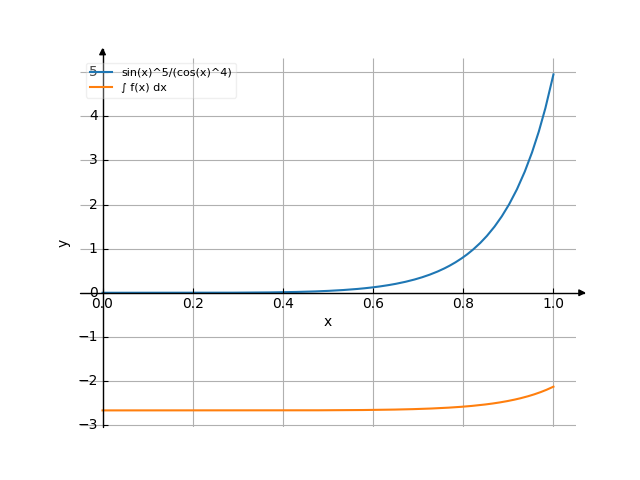Integral of sin^5x/cos^4x dx
The solution
1 / | | 5 | sin (x) | ------- dx | 4 | cos (x) | / 0
Integral(sin(x)^5/(cos(x)^4), (x, 0, 1))
-
Rewrite the integrand:
-
There are multiple ways to do this integral.
Method #1
-
Let .
Then let and substitute :
-
Rewrite the integrand:
-
Integrate term-by-term:
-
The integral of a constant is the constant times the variable of integration:
-
The integral of a constant times a function is the constant times the integral of the function:
-
The integral of is when :
So, the result is:
-
-
The integral of a constant times a function is the constant times the integral of the function:
-
The integral of is when :
So, the result is:
-
The result is:
-
-
Now substitute back in:
Method #2
-
Rewrite the integrand:
-
Let .
Then let and substitute :
-
Rewrite the integrand:
-
Integrate term-by-term:
-
The integral of a constant is the constant times the variable of integration:
-
The integral of a constant times a function is the constant times the integral of the function:
-
The integral of is when :
So, the result is:
-
-
The integral of a constant times a function is the constant times the integral of the function:
-
The integral of is when :
So, the result is:
-
The result is:
-
-
Now substitute back in:
Method #3
-
Rewrite the integrand:
-
Integrate term-by-term:
-
The integral of sine is negative cosine:
-
The integral of a constant times a function is the constant times the integral of the function:
-
Let .
Then let and substitute :
-
The integral of a constant times a function is the constant times the integral of the function:
-
The integral of is when :
So, the result is:
-
Now substitute back in:
-
So, the result is:
-
-
Let .
Then let and substitute :
-
The integral of a constant times a function is the constant times the integral of the function:
-
The integral of is when :
So, the result is:
-
Now substitute back in:
-
The result is:
-
-
-
Add the constant of integration:
The answer is:
/ | | 5 | sin (x) 2 1 | ------- dx = C - cos(x) - ------ + --------- | 4 cos(x) 3 | cos (x) 3*cos (x) | /
2
8 -1 + 6*cos (1)
- - cos(1) - --------------
3 3
3*cos (1)
=
2
8 -1 + 6*cos (1)
- - cos(1) - --------------
3 3
3*cos (1)

Use the examples entering the upper and lower limits of integration.

![Find the integral of y = f(x) = sin⁵x/cos⁴x dx (sinus of to the power of 5x divide by co sinus of e of to the power of 4x) - with detailed solution [THERE'S THE ANSWER!] sin^5x/cos^4x](/media/krcore-image-pods/176/hash/indefinite/c/91/d748f496e1d2108b3fdc1bb32790d.png)
 Integral of tan^6(x)×sec^4(x)
Integral of tan^6(x)×sec^4(x)
 Integral of sin(pi*x/2)
Integral of sin(pi*x/2)
 Integral of sin^5x/cos^4x
Integral of sin^5x/cos^4x
 Integral of cos(4x-5)dx
Integral of cos(4x-5)dx